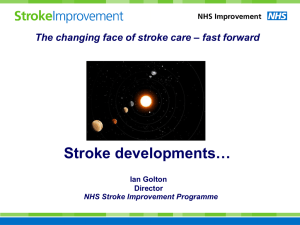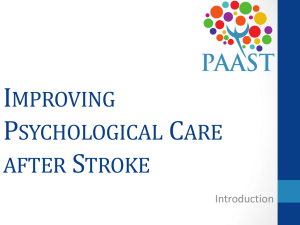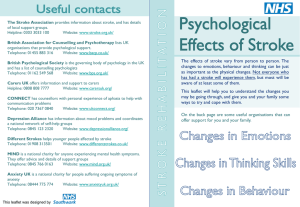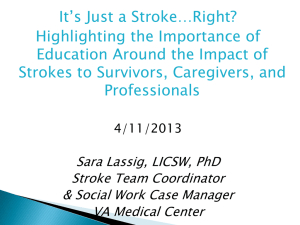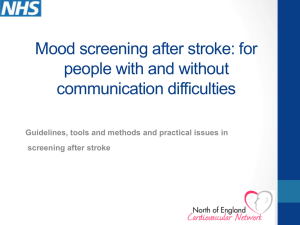Psychological Impact of Stroke - the HIEC Stroke Events Website
advertisement
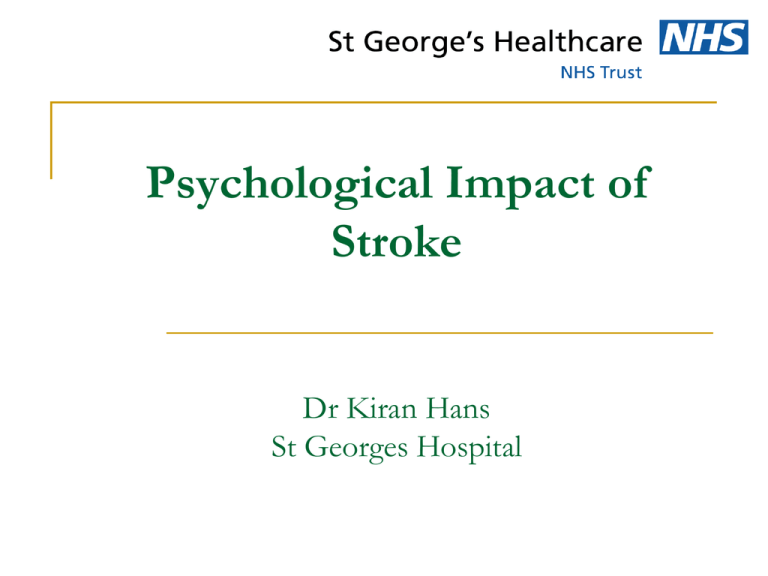
Psychological Impact of Stroke Dr Kiran Hans St Georges Hospital Agenda Stroke definitions Psychological disorders after Stroke The psychological impact of Stroke 3 levels of assessment & intervention Case examples References Stroke definition Medical definition: “A clinical syndrome of rapid onset of focal or global cerebral deficit lasting more than 24 hours or leading to death, with no apparent cause other than a vascular one”. Psychological definition: “A stroke is a sudden and often traumatic major life event that usually occurs with minimal warning and, for many, results in life-changing consequences” (Donnellan et al., 2006) Psychological disorders after stroke Psychological disorders after stroke have been well documented Depression: 35 – 50%% Anxiety Disorder: 25% Apathy: 20% Pathologic affect 20% Catastrophic reaction: 20% Mania: rare Bipolar disorder: rare Psychosis: rare Why do psychological problems develop? Location of brain injury Adjustment to sudden life changes Or both … Impact of stroke on self & others Physical Sensory Communication Cognitive Behavioural Emotional Impact of stroke on self & others Physical Sensory Communication Cognitive Behavioural Emotional They affect many levels -: Personal Sense of self Identity Family Role change Work Responsibilities Finance Society Stigma Social networks Health services Common psychological difficulties after Stroke Normal reaction to an abnormal event Sad feelings / Low mood Sleep problems – not sleeping through the night, restless sleep Anxiety – fear of falling, looking out for stroke signs Agitation & Frustration Worrying about the future – “how will I cope”, “what if it happens again” This reaction can become persistent, which can lead to -: Disengaging with therapy sessions Feelings of hopelessness Preoccupation with lost skills or roles Unable to adjust to loss / changed sense of identity Striving for an unrealistic degree of recovery Repeated failure leading to loss of confidence Strained family relationships Tyerman (2008) What to look out for? Depression Feeling sad (verbally or body language) Tearful Not engaging in rehab & generally de-motivated Not sleeping well / sleeping too much or too little Less interest in eating / always eating Constantly thinking about what has happened and asking why Anxiety Unable to relax Nervous Scared Fear of the worst happening / losing control Heart racing Panicking Quick and shallow breathing Why assess? Assessment helps establish what the problem is i.e. mood, dementia, behaviour, etc. Early assessment Delayed psychological intervention can lead to early intervention Higher rates or mortality Increased disability Secondary health problems Secondary psychiatric problems (e.g. Depression, Health & / or Social anxiety, Panic Disorder +-agoraphobia) Increased carer burden Intervention Provision of psychological care is multifaceted & involves many professions and agencies Stepped care approach advocated by NICE & ASI Level 3 Level 2 Level 1 What to do at Level 1? MDT to administer prelim mood screen – “Do you feel sad or depressed?” Initial assessment using a brief standardised measure HADS, SADQ-H, GDS, DISCs, Visual analogue If sub-threshold – MDT to use low level supportive strategies Provide information about stroke & rehabilitation pathway Make the environment pleasant Acknowledge the patient’s distress Active listening Validate their feelings – “I can see that you are upset” Normalise their feelings – “I understand why you feel upset” Engage in pleasurable activity What to do at Level 2? Mood assessment interview by CP Standardised assessment HADS, SADQ-H, GDS, DISCs or other Visual analogue Risk Assessment Presenting problem, History of mood related difficulties, perception of what is happening, support network, health related behaviours and attitudes, goals and perceived progress Current plans, History Interventions from Level 1 + 2 In collaboration with CP, the MDT can use Supportive counselling, explicit feedback and positive reinforcement, motivational interviewing & goal planning Medics to consider pharmacological intervention What to do at Level 3? Mood assessment interview by CP Standardised assessment Risk Assessment Referral to Neuropsychiatry / Mental Health Team / GP IAPT Interventions from Level 1, 2 & 3 CP to use formal psychological interventions Behavioural therapy (incl. relaxation, distraction, breathing exercises) Cognitive-Behavioural Therapy Solution Focused Therapy Systemic Therapy Motivational Interviewing Goal Setting Adjustment is an ongoing process! No time limit Adjustment difficulties can be on-going Social support groups can be very helpful at this stage (e.g. Stroke Association, Stroke Adjustment Group) Gary was a 75 year old retired businessman. He lived alone and was very independent. He had three grown up children whom he met regularly. Gary sustained a shower of emboli within the anterior and posterior intracranial circulations which led to multiple infarcts. During Gary’s admission he become very low in mood, he lost his appetite and needed sleeping tablets at night. He would spend most of his day sleeping or thinking about the stroke and how his life had changed. He was reluctant to engage in rehab sessions and saw little point in being alive. He received psychological support from the MDT with the aim of helping him understand his behaviour and challenge some of his negative thoughts. He was also given more information about his brain injury and strategies to help him cope with the cognitive changes. He was given tips on sleep hygiene to help him sleep at night and a collaborative goal planning approach was used to engage him in his rehabilitation. He was also encouraged to go to the hospital coffee shop for lunch with his children to build his appetite. Jenny was a 47 year old lady who worked long hours in the city as an investment banker. She had a right temporoparietal intracerebral haemorrhage. She was extremely anxious during her admission to the Stroke unit. Her anxiety was frequently reflected by her catastrophic thinking (i.e. that the worst has happened) and continual need for reassurance about her well-being. She also frequently queried whether all had been done to help her. Jenny’s initial anxious state tended to elevate her blood pressure, which in turn lead to unpleasant physical symptoms. She was hyper-sensitive to these symptoms, which then acted to reinforce her fears that she may have another Stroke. Jenny was given behavioural strategies to manage her anxiety (distraction, muscular relaxation and deep breathing), which she used well. When she was successful in managing her anxiety she noticed a reduction in her blood pressure. She was given information about Stroke and how to manage her risk factors. References British Psychological Society (2008) Concise guide for stroke Department of Health (2007) National Stroke Strategy National Institute for Health & Clinical Excellence (2008) Depression in adults with a chronic physical health problem National Institute for Health & Clinical Excellence (2008), Stroke Royal College of Physicians (2004) National Clinical Guidelines for Stroke, Second Edition NHS Improvement (2011) Psychological care after stroke; improving stroke services for people with cognitive and mood disorders Questions Contact details -: Dr Kiran Hans Clinical Psychologist Stroke Services Tel: 020 8672 1255 ext: 4467 Kiran.Hans@stgeorges.nhs.uk




